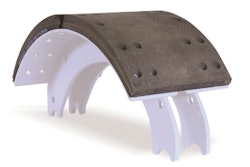
National Tire Safety Week is observed May 29 through June 4.
The Rubber Manufacturers Association sponsors National Tire Safety Week as part of its year-round efforts to raise awareness of tire care and maintenance issues.
The experts at Bendix recommend keeping the following four “Pressure Points” in mind when it comes to tire inflation.
Safety
According to industry research, 90 percent of tire blowouts can be attributed to underinflation, and nearly half of all emergency service road calls are tire-related.
Correctly inflated tires also help to ensure the best performance of today’s most advanced commercial vehicle safety systems: Reduced Stopping Distance (RSD)-compliant brakes, full-stability, and collision mitigation systems are all optimized when the vehicle they’re protecting is running on properly maintained tires.
“Whether you’re talking about high-performance drum brakes, air disc brakes, or the leading-edge technologies like Bendix Wingman Fusion, any component that can play a role in the vehicle’s stopping ability can find its performance hindered when tires aren’t kept at the proper pressure and in good working condition,” says Jon Intagliata, Bendix’s product manager for Tire Pressure Monitoring Systems (TPMS).
“That’s why it’s so important to catch low-pressure situations quickly and remedy them the same day they are discovered.”
Tire Temperature
During normal vehicle operation, tire temperature increases – which causes tire pressure to rise as well. The SmarTire Tire Pressure Monitoring System (TPMS) by Bendix CVS for tractors and SmarTire Trailer-Link TPMS by Bendix CVS for trailer systems both use wheel-mounted sensors to continuously monitor temperature, as well as pressure inside each tire. These sensors enable the system to provide a deviation value that shows the amount of overinflation or underinflation from the tire’s cold inflation pressure (CIP), automatically taking into account any increase in pressure due to temperature, and adjusting driver alerts accordingly. As a result, these systems can not only address changing situations that can affect pressure – such as whether a truck has been parked for some time or has traveled hundreds of miles – but also provide earlier warnings of potential tire problems.
Cost Savings
Because fuel and tires are typically among fleets’ largest expenses, maintaining the right tire pressure every day over miles and miles pays dividends in both fuel savings and tread life. Underinflation by as little as 10 percent can result in a 1.5 percent drop in fuel economy, according to research by the American Trucking Associations’ Technology & Maintenance Council (TMC), and underinflation by 20 percent results in a 30 percent reduction in tire life.
A TPMS can also address tire-related downtime costs: The real-time status information these systems provide to drivers or maintenance technicians both warns of tire problems before they pose a safety hazard, and also eliminates the need for manual pressure checks. Tire inspections and maintenance are made more efficient since terminal operators can tell in advance which tires may need pressure adjustment.
Big-Picture Planning
With the right equipment and organizational planning, fleets can sharpen their maintenance team’s scheduling and shape a fleet-wide tire strategy.
SafetyDirect from Bendix CVS – a web portal that allows fleet owners to analyze real-time, wirelessly transmitted safety information – connects to systems like SmarTire and provides tire pressures, temperatures, and alerts to the back office. This enables fleet maintenance teams to plan specific vehicle service in advance, while fleet managers can examine and consider factors such as tire replacement frequency, tire repair downtime, and occurrences of roadside breakdowns due to tire failure.
“There’s really no such thing as taking too much care when it comes to a truck’s tires,” Intagliata says. “So many aspects of safe vehicle operation – and, by extension, highway safety – depend on their maintenance and inspection. That’s why we’ll continue to work on developing and improving ways to keep fleets and drivers running on safe, properly inflated tires in all situations and conditions.”











